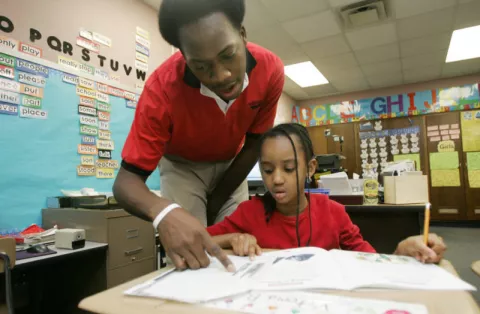Key Takeaways
- As staff shortages deepen across the country and workload increases, more educators are feeling burned out and demoralized.
- Research shows that school leaders who protect teachers’ time, invite their input, and support their mental health and well-being through comprehensive programs see higher levels of satisfaction.
- Unions have been pushing districts to address shortages, reduce the extreme demand on educators, and hire more health and wellness coordinators.
A survey of U.S. public sector workers released in October found that K-12 public school educators were the most likely to report higher levels of anxiety, stress and burnout during the COVID-19 pandemic. That's obviously no surprise. After a quick and difficult transition to full-time virtual learning, to the unrelenting pressure to return to school before the approval of the vaccines, to being targets in heated, potentially dangerous political battles, educators have endured staggering levels of anxiety and pressure.
Districts are also reporting shortages of classroom teachers, cafeteria workers, bus drivers and substitute teachers, exacerbating an already tense environment for educators who—for now at least—choose to remain in their profession. Nearly four in 10 reported that working during the pandemic has made them consider changing jobs, mirroring recent surveys from the National Education Association and the RAND Corporation that found high percentages of teachers thinking about exiting the profession
However, compared to other public sector workers, K-12 employees were more likely to say they prefer to stay in their jobs.
Educators like Charity Turpeau, the 2021-22 middle school teacher of the year in her Louisiana school district, love being in the classroom, but are worried about the mounting pressures of the job and the lower pay. "With the workload, demands from the state, pandemic restrictions, and lack of pay, I feel as if I am doing less of what I love, which is teaching," she told Good Morning America hosts on Nov. 8. "The paycheck does not match the amount of workload we are given and the overtime we work to try and complete it all."
If the education system is to avoid the fast approaching "teacher turnover cliff," says Doris Santoro, professor of education at Bowdoin College in Maine, districts and school leaders have to focus on structural change in schools beyond doing what is necessary to fill shortages.
"These are opportunities for school leaders to really look at what we are asking teachers to do. Let's eliminate the part so the job that are not as important. Give them the choices in the kinds of work they do. There is incredible power in giving educators work that they find meaningful and important."
Desperate for Relief
Turpeau says burnout among educators is more prevalent now than at any time in her 16 years of teaching.
Demoralization is equally prevalent. "Burnout and demoralization are meaningfully different forms of work dissatisfaction that each affect teachers’ ability to do their jobs and influence decisions to remain in the profession, Santoro says.
Burnout is often a more temporary condition in which an educator has exhausted the personal and professional resources necessary to to the job. Demoralization occurs when an educator believes she is unable to perform the work in ways that uphold the high standards of the profession.
“Although often portrayed as the capacity for individual resilience, burnout can also be the result of unusually demanding school environments that lack appropriate organizational supports or limits.” - Doris Santoro and Olga Acosta Price
Having to give up academic planning time to cover additional tasks can undoubtedly have that effect. Amid staffing shortages, educators in Montgomery County, Maryland, have seen their planning time shrink in the face of mounting demands and are sounding the alarm.
Standing outside the board of education offices on November 9, Montgomery County Education Association (MCEA) President Jennifer Martin said, “We don’t have the time for the self-care our employer tells us to take. We normally take on extra work for the good of the students, but there is just too much. MCPS employees are demoralized, exhausted, and desperate for relief.”
“It’s beyond frustrating," said MCEA Vice President Nikki Woodward. "Educators are holding on by strings. Something has to give.”
Montgomery County currently has vacancies for 325 teachers, about 105 paraeducators, nearly 100 other support staff and about 120 bus drivers. MCEA is calling for a moratorium on new initiatives introduced into the school system, additional early release days for more planning time, and better pay to recruit and retain substitute teachers.
Martin said that under “normal” circumstances, a teacher’s day is already packed. Employee shortages have made an already heavy burden unsustainable. Unless the situation improves, she warned, the "great resignation" may be looming.
Focus on Educators of Color
In a new policy brief, Santoro and Olga Acosta Price, director of the Milken Institute School of Public Health at George Washington University, condense some of the most critical findings around burnout and demoralization as educators and students try to adjust to the fallout from the pandemic.
“Evidence is growing that the pandemic has increased demoralization and burnout among many teachers," they write. "Surveys of teachers as the pandemic began highlight the rising stress and plummeting morale that many teachers have felt across the course of the year.”

The brief also spotlights how burnout and demoralization may be disproportionately impacting educators of color, who tend to leave the profession at higher rates than their white colleagues. Santoro and Acosta Price cite data demonstrating these educators are facing high levels of race-based stress in school, "which has a significant effect on their professional self-efficacy and sense of belonging."
Earlier this year, Santoro collaborated with two public school educators in Portland, Maine, Julia Hazel and Alberto Morales, to examine the experiences and working conditions of educators of color in their district.
Even in a community that is conscious of social justice and equity (the district supported the researchers' project), the researchers learned how incredibly difficult it is for educators of color to thrive, especially in schools that cater to White staff.
In addition to the extra demands placed on every staff member, educators of color in Portland are tasked with mentoring or counseling students of color and other uncompensated "identity-based labor," while also being challenged regularly by White colleagues over their pedagogical choices.
Educators of color experience burnout over workload, but it is the climate of the school which contributes to their demoralization. "If they don’t mimic the dominant mode of doing things, they are questioned all the time," Santoro says.
Strategies Work Better Than Others
The paradox is that some extra work, particularly if it involves interacting directly with students, can be rewarding. Still, schools tend to be unaware on how taxing extra work and assignments are on educators—not to mention the impact on student learning.
Addressing the understaffing of schools to alleviate the current crisis is critical, but that could be a short-lived success without systemic changes.
Recruiting and retaining educators starts with a professional salary. According to a new report by the Teacher Salary Project, nearly half of the teachers surveyed said their salary was not sufficient to keep them in the profession.
Other surveys also find that lack of support and working conditions are just as likely to drive educators out of the profession.
Designing and implementing school structures and policies that combat burnout and demoralization should be every district's focus.
In their policy brief, Santoro and Acosta Price urge districts to neutralize the forces that contribute to high turnover of educators of color by making racial and social justice a priority in schools. In addition, schools should ensure curriculum and learning and work environments are respectful and inclusive. "Addressing the personal and professional well-being of educators of color is vital to recruitment and retention," Santoro says.
Furthermore, schools can and should support educator well-being by normalizing and embedding comprehensive mental health supports.
That means fewer wellness one-offs.
"I think these are well-intentioned, but this is about more than one-day trainings, free chair massages, breathing exercises and Casual Fridays," says Santoro. "Those are all good, but it is not what educators need to reduce burnout and improve morale or their long-term well-being."
Educators will feel more supported by school leaders—and therefore more likely to remain in the profession—who prioritize decreasing administrative paperwork and who protect their time to do what they believe is best for their students.
"This is about support and autonomy," says Santoro, who adds that school leaders should start those conversations now.
"They should be asking educators, 'what is the most time-consuming part of your job, what tasks aren't as important and what are the systems that we can put in place so you can do the work that you think matters most?'"


